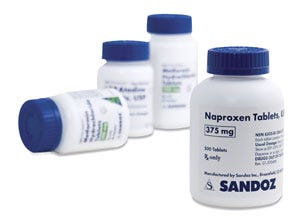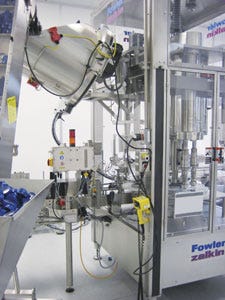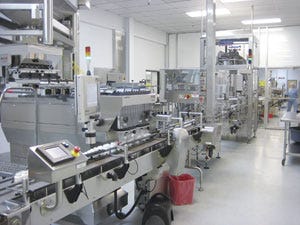|
Sophisticated, new cappers at Sandoz, Inc., Broomfield, CO, are paying big dividends for the U.S.'s largest manufacturer of generic pharmaceutical products. Sandoz, which manufactures more than 200 products in more than 500 package sizes, has two U.S. manufacturing plants, but Broomfield is its primary facility.
Three years ago, Sandoz installed an eight-head rotary capper from Fowler Products Co. that worked very well. When the company decided last year to further upgrade its packaging operations, it reviewed the cappers on the market and then purchased a new Fowler CAS-6/360 six-head rotary capper.
“We've used a number of different cappers, but we like the Fowler machines the best,” says packaging development manager Mark Kuhl. “They are built like a tank, and Fowler has done a great job integrating U.S. components onto the base European machine. They have reduced downtime and increased productivity because they produce less scrap and are much quicker to change from one bottle to another. We couldn't be happier.”
Says Kuhl, “We had several lowspeed lines, and we needed to increase productivity, so we rebuilt our filling room and purchased the second Fowler capper along with a new desiccant dispenser and tablet counter. We modified an existing bottle orienter and installed existing downstream equipment including a labeler and case packer. The new line runs 120 bottles of tablets per min ranging in capacity from 125 to 250 cc.”
To start the operation, HDPE bottles, which are supplied by Berry Plastics Corp., are oriented by a machine from Omega Design Corp. As part of the process, the machine blows them out with ionized air. The bottles are then conveyed to an intermittent motion desiccant dispenser from Jushay Corp. The desiccant pouches are supplied on a roll by Sud-Chemie Inc., and the dispenser cuts them apart and drops them into the bottles on the conveyor below.
Vibratory-feed tablet counter
Next, the bottles are conveyed to an intermittent-motion SwiftPharm vibratory-feed tablet counter from IMA Nova that fills four bottles at a time. The bottles are metered into the machine through a feed screw, and the machine controller allows four bottles to enter the machine for each bottle filling cycle, after which the feed screw stops.
|
This six-head rotary capper is specifically designed for pharmaceutical applications. It is completely lube free and features quick, toolless changeover for cap and bottle handling parts. |
The tablets to be filled are dumped into a 500-kg-capacity bin that is then lifted to the top of the tablet feeder by a column lift. The bin pivots and discharges the tablets into the feeder hopper through a butterfly valve. This unit is supplied by Custom Powder Systems LLC.
From the hopper, the tablets are delivered to the bottles through 12 channels on three sets of vibrating trays in series. The trays are divided into four segments across the machine with each segment having three vibrating channels. Each of the three-channel segments handles tablets for one bottle.
The purpose of the three trays in series is to spread the tablets out so that they are separated by the time they drop from the last tray so they can be counted, which is done by photo arrays at the end of each channel. The number of tablets being delivered from the feed hopper is adjusted manually to satisfy the requirements of the bottles being run by adjusting the amplitude of the vibration on the first tray beneath the hopper.
The quantity is then fine-tuned by a controller on each channel that automatically adjusts the amplitude of the tray vibration during the operation to deliver more or fewer tablets based on the tablet count at the end of that channel.
Ultimately, individual tablets drop off the ends of the 12 channels into 12 chambers called precount gates. From these, the tablets drop into four more chambers called catch boxes, each of which receives tablets from three precount gates. When a catch box has the number of tablets required to fill the bottle, based on the count from the photo array, a gate above the box closes and a gate beneath the box opens and discharges the tablets into the bottle on the conveyor below.
|
A new packaging line, top, combined existing equipment with a new vibratory feed tablet counter and rotary capper. Bottom, the rotating cap-transfer star wheel picks up the caps and the capping heads descend and pick up the caps for application to the bottles. |
|
The purpose of the dual level of accumulation chambers is to ensure that vibrating trays never have to stop. Thus, the precount chambers accumulate tablets while the catch box is discharging to the bottles. When this is finished, the tablets in the precount gate drop into the catch box, and subsequent tablets fall through the precount gate without stopping.
When all four bottles are filled, they are released and four more bottles enter the unit.
“We are very pleased with this tablet feeder,” says Kuhl. “Running different products can be tricky, and there is definitely a learning curve involved, but the self-correcting feature for the tray vibration helps the operation.”
Six-head capper
Bottles leaving the tablet counter are conveyed to the Fowler Model CAS-6/360 six-head rotary capper mentioned previously. Bottles are metered into the continuous-motion capper through a feed screw and then travel around a star wheel into the center starwheel, which transports them around the capper.
Caps, which are made by Rexam PLC and distributed to Sandoz by Tricor Braun, are loaded into a floor hopper and lifted up to the overhead cap hopper by a cleated elevator. The caps drop into a rotary sorter that orients them in an open-side down configuration and delivers them into the cap track where they travel down into the capper.
A rotating cap-transfer starwheel picks the caps from the end of the cap track and the capping heads, which are equipped with hysteresis-magnet chucks, descend and pick up the caps with three-segment jaws.
The heads descend onto the bottles and the chucks rotate to tighten the caps to the set torque, after which the jaws open, the heads rise and the bottles exit the machine through a starwheel.
The capper at Sandoz, which is specifically designed for pharmaceutical applications, is lube free and features quick, toolless changeover for cap and bottle handling parts.
Bottles are then conveyed to the downstream equipment.
More information is available: |
Berry Plastics Corp., 812/424-2904. www.berryplastics.com. |
Custom Powder Systems, 417-868-8002. www.custom-powder.com. |
Fowler Products Co., 706/549-3300. www.fowlerproducts.com. |
IMA Nova, 978/537-8534. www.novaps.com. |
Jushay Corp., 716/662-8215. www.jushay.com. |
Omega Design Corp., 610/363-6555. www.omegadesign.com. |
Rexam PLC, 812/867-6671. www.rexam.com. |
Sud-Chemie, Inc., 502/634-7200. www.sud-chemie.com. |
TricorBraun, 800/325-7782. www.Tricorbraun.com.. |
About the Author(s)
You May Also Like






